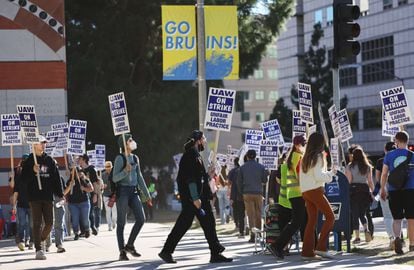Massive strike at University of California enters third week
Nearly 50,000 academic researchers and teaching assistants have downed tools, threatening to derail spring admissions and cause exam chaos as employees demand salary hikes in line with spiraling living costs

/cloudfront-eu-central-1.images.arcpublishing.com/prisa/MLSKZDBO6XO4I7JHTZJGYMRK6M.jpg)
Pablo Quílez arrived in San Diego a month and a half ago. The Spanish physicist, who had previously spent time un universities in Madrid and Hamburg, started a three-year post-doctoral stay at the prestigious University of California, one of the most important public institutions in the United States. What the 31-year-old Quílez stepped into almost immediately was one of the largest academic strikes in US history. Around 48,000 academic employees – almost 18% of the entire faculty – have joined the action, which is calling for improvements in salaries and living conditions. “I was shocked that there are doctoral students living in their cars or spending 85% of their salaries in rent. Rents are sky-high and salaries are dreadful,” Quílez, who has joined the strike, told EL PAÍS by telephone.
The strike, which started on November 14, is affecting 10 university campuses throughout California. It is made up of teaching assistants, researchers, postdoctoral students and others who work at one of the university’s 800 research centers. The strike excludes tenured and tenure-track professors and lecturers at the institutions of Berkeley, Davis, Irvine, Los Angeles, Merced, Riverside, San Diego, San Francisco, Santa Barbara and Santa Cruz, some of which are among the top 20 in the country.
Full professors, who carry the bulk of the academic weight in the day-to-day running of an institution with 280,000 students, have shown solidarity with those who have gone on strike. Researchers often serve as teaching assistants who interact with students outside of the classroom environment, answering questions in person or via email.
The root of the problem is that members of this group can barely get by on what they earn. The situation has been spiraling out of control for several years, but in 2022 it has become unsustainable. “The huge rise in inflation was the straw that broke the camel’s back and led faculty employees to organize themselves,” says Quílez, who adds he was surprised by the long lines at the food bank on the San Diego campus, which included academics and students. “It’s looked upon as normal for them to be collecting food at one of the most prestigious universities in the world,” he says.
Last summer, the San Diego campus publicly announced a milestone: it had become the youngest educational institute in the country to raise more than $1 billion in donations. Over the course of a little over a decade, it has banked $3.05 billion from more than 163,000 patrons.
That figure has resurfaced on several occasions over the last few weeks in the heat of the protests, which call for salary increases and solutions to the housing crisis many university employees are facing. The minimum annual salary for associate professors and researchers without a doctorate is $24,000 a year: for doctorate researchers this figure rises to $55,000, which translates to around $3,700 net per month, although the amount can vary depending on experience, the number of hours worked and the school in which they work.
One thing that everyone appears to agree on is that these salaries are insufficient to meet rent demands in a state as expensive as California. In Santa Cruz, a city 70 miles to the south of San Francisco, those minimum incomes fall some $15,000 short of the average annual rent for an apartment. The problem becomes more acute in cities like Los Angeles, San Diego or Berkeley, where the price for a one-bedroom apartment close to the campuses can easily reach $2,600 a month. Quílez highlights the perversity of this scheme, as much of the housing occupied by academic workers is owned by the educational center itself. “The university decides the salaries, which are pitiful, but also sets the astronomical rents. It’s crazy,” he says.

“Overwhelming financial impacts”
Rent can devour 50% or more of a teaching assistant’s income. Izzy Muise, an academic at UC Davis, says 75% of her salary goes on rent. To make ends meet - and to be able to cover utility bills or buy food - she needs the support of her parents. “This is a luxury that the vast majority of employees don’t have,” says Muise, a chemistry faculty member. In almost all cases, the 30% ceiling recommended by the federal government for rent expenditure is comfortably exceeded.
Pradeep Khosla, chancellor of the University of California, San Diego, has attributed the situation to the ravages of the pandemic and market forces. The collective bargaining agreement is renegotiated every five years and the first post-pandemic discussions are underway. The University of California’s offer to employees is a 7% salary increase for those in their first year and a 3% increase for subsequent years. This has been rejected. Instead, a base salary of $54,000 for teaching assistants and pre-doctoral researchers and $70,000 per year for postdoctoral researchers has been put on the table. The researchers are demanding a 14% salary increase and that subsequent increases keep pace with housing costs.
Michael Brown, provost and executive vice president for academic affairs at the University of California, made it clear that it would be difficult to meet the demands of employees, who are unionized within two sections of the powerful UAW that represents auto, aerospace and agricultural workers. “Tying compensation directly to housing costs […] could have overwhelming financial impacts on the University,” Brown said in a letter laying out the institution’s offer and dated the day after the strike began. One university report suggested that these costs would run to “at least several hundred million dollars” annually.
Aside from salaries and housing costs, the negotiations between the parties include other matters such as financial support and allowances for staff who are mothers or fathers, extended parental leave, health insurance plans and subsidies for on-site parking.
The strike has placed a temporary halt to the research that has made UC a world leader. But the shorter-term impact will be felt in the next few days, when tens of thousands of students across the university’s 10 campuses begin their final exams. The grading of these and the reading of end-of-semester essays are largely the responsibility of the academic employees and researchers who are on strike. Delaying grades could lead to chaos and derail spring admissions. It is then when the strength of a faculty movement that has been largely invisible until now might come into sharp relief.
Sign up for our weekly newsletter to get more English-language news coverage from EL PAÍS USA Edition
/cloudfront-eu-central-1.images.arcpublishing.com/prisa/LPKB2ZJRM5T5L5IRMXAR3Y3NII.jpg)











































